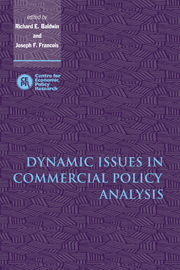Book contents
- Frontmatter
- Contents
- List of figures
- List of tables
- Preface
- List of conference participants
- 1 Introduction
- 2 Transition dynamics and trade policy reform in developing countries
- 3 Putting growth effects in computable equilibrium trade models
- 4 Innovation, capital accumulation, and economic transition
- 5 Multinational production, skilled labour, and real wages
- 6 Economic policy and the manufacturing base: hysteresis in location
- 7 Trade liberalization and investment in a multilateral framework
- 8 Investment creation and investment diversion: simulation analysis of the Single Market programme
- 9 Blueprints, spillovers, and the dynamic gains from trade liberalization in a small open economy
- 10 Trade policy and North–South migration
- 11 Long-term modelling of trade and environmental linkages
- 12 Labour markets and dynamic comparative advantage
- Index
5 - Multinational production, skilled labour, and real wages
Published online by Cambridge University Press: 13 January 2010
- Frontmatter
- Contents
- List of figures
- List of tables
- Preface
- List of conference participants
- 1 Introduction
- 2 Transition dynamics and trade policy reform in developing countries
- 3 Putting growth effects in computable equilibrium trade models
- 4 Innovation, capital accumulation, and economic transition
- 5 Multinational production, skilled labour, and real wages
- 6 Economic policy and the manufacturing base: hysteresis in location
- 7 Trade liberalization and investment in a multilateral framework
- 8 Investment creation and investment diversion: simulation analysis of the Single Market programme
- 9 Blueprints, spillovers, and the dynamic gains from trade liberalization in a small open economy
- 10 Trade policy and North–South migration
- 11 Long-term modelling of trade and environmental linkages
- 12 Labour markets and dynamic comparative advantage
- Index
Summary
Introduction
International trade has a long tradition of explaining trade flows and international differences in sectoral production levels by differences in relative factor endowments among countries. Dual results relate real factor rewards to international prices and trade barriers. But factor-proportions trade theory, at least in its traditional competitive formulation, is not well suited to discussions about the role of trade in technologies and knowledge capital in determining real wages and national standards of living. Because of problems relating to the public goods nature of knowledge or to the firm-specific character of knowledge and skills, the services of these assets are often exploited internally within multinational firms in serving foreign markets.
Many theoretical and empirical developments have improved our understanding of which firm-level characteristics lead to industries dominated by multinationals. More recently, we have begun to incorporate these firm-based models into the general equilibrium theory of international trade so that we understand, for example, which country characteristics lead to international activity dominated by direct investment rather than trade.
The purpose of this paper is to exploit these recent developments in order to improve our understanding of how multinationals in turn influence certain variables in equilibrium, outputs and factor prices in particular. While previous work has given us a basis for understanding how country characteristics such as size, relative endowments, and trade costs lead to multinational firms, we now turn to the question of how the introduction of multinational production alters the inter-country distribution of production and the intra-country distribution of income.
We adapt our two-country, two-sector, two-factor static model developed in Markusen and Venables (1995a, 1996).
- Type
- Chapter
- Information
- Dynamic Issues in Commercial Policy Analysis , pp. 138 - 176Publisher: Cambridge University PressPrint publication year: 1999
- 5
- Cited by



